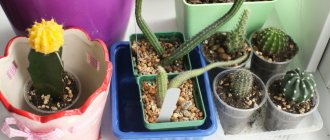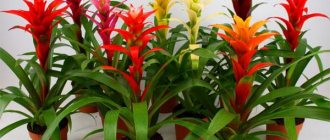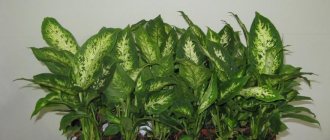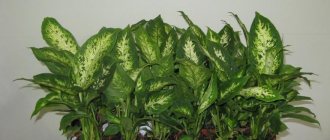Distinctive features
This plant has a rather unusual appearance. Despite its name, the indoor bamboo used in the design is actually a type of dracaena. Bamboo at home (the photo demonstrates this) looks quite attractive. It grows equally well both in soil and in ordinary water. It has a bare stem of a rich green hue. There are leaves at the top of the plant. Home interiors are often decorated with spiral-shaped bamboo, whose shoots grow in zigzags. According to Eastern mythology, this plant can bring good luck in any endeavor. It is not for nothing that spiral bamboo is called the tree of happiness. How to grow bamboo at home?
Prevention
What measures can be taken to ensure that indoor bamboo remains green and does not turn yellow?
Pot
Choose deep pots for planting the plant, as its roots grow just deep. The diameter should not be wide. Such a container will optimally satisfy the specific requirements of the plant for its place of residence.
Transfer
Carry out this procedure regularly, without waiting for the bamboo to signal with its yellow leaves that it is cramped. In addition to being cramped, the soil in the pot is also depleted, which can also affect the appearance of the plant.
Water preparation
Bamboo Lucky at home looks perfect in any vase with water. For this plant, purified or distilled water is specially prepared and brought to an acceptable temperature. To grow bamboo in water, home care must meet the requirements of this plant. For example, it is recommended to completely change the liquid in the vase every fifteen days. Experienced flower growers prepare melt water from ordinary water collected from the tap. To do this, place a plastic bottle with liquid in the freezer and then defrost it.
Lighting and temperature
When growing Lucky bamboo, care at home will not be difficult. This is a fairly heat-loving plant that does not tolerate temperatures below eighteen degrees very well. Due to the cold weather, bamboo in water may develop fungus. But this plant can withstand hot weather well.
To grow spiral bamboo, care at home must be thorough. One of the main conditions is the presence of clean water in the vase. If it is deficient, bamboo leaves turn yellow and dry out. It is not advisable to place this plant in direct sunlight. Ideal for bamboo is close proximity to the window, but subject to the presence of curtains. Lack of light negatively affects the shape of the flower, as it slows down its development and leads to deformation of the stem.
Feeding and humidity
At home, bamboo in water can grow up to two meters. Fertilizer is added only to clean water. Experienced gardeners advise feeding bamboo every sixty or seventy days. As a fertilizer, it is best to use a regular kit for indoor flowers containing nitrogen. In winter, it is recommended to spray the leaves and moisten the stem. For convenience, as a rule, a spray bottle is used. You can also purchase a humidifier. This southern plant loves moisture and warmth. Therefore, the owner’s task is to provide his pet with the necessary conditions.
Do not allow dust to accumulate on the leaves and stem of the plant, as it leads to wilting and an unhealthy appearance. In addition, a container with crushed stone is usually placed under a vase with Lucky bamboo and water is poured. Moreover, the liquid remains at such a level that the drainage does not disappear under water.
Pests
Bamboo can also be affected by pests: aphids and thrips are the most common ones.
Thrips
Miniature insects leading a parasitic lifestyle. They are able to fly, which increases the risk of infecting other indoor flowers. In addition, thrips reproduce at a record pace and are able to colonize the entire plant in a limited time.
If you look at the leaves of bamboo infected with thrips, you will see a cluster of small brown crawling insects. Pests are dangerous because they suck nutritious juices from plant tissues, thereby weakening the bamboo. In addition, parasites also transmit diseases.
As a result of thrips damage, bamboo may lose its foliage and lose its decorative properties. You need to start the fight as early as possible, using insecticides:
- Vertimek;
- Aktelik;
- Fitoverm et al.
Aphid
This small parasite settles on the leaves, sucking their juices. Despite its miniature size and apparent harmlessness, the reproduction of a colony of aphids can even lead to death of bamboo. This insect in itself does not bring anything good to the plant, and is, in addition, a carrier of fungal infections.
It is more difficult to deal with aphids than with thrips, since the insect has good resistance to many insecticides. It is therefore necessary to use “heavy artillery”:
- Karbofos;
- Kinmiks et al.
If there are still a few aphids, folk remedies in the form of oil solutions, natural sprays of St. John's wort, yarrow, citrus fruits, and celandine will also help.
Pruning and crown formation
In order to create the required shape, pruning is carried out occasionally. For example, most often at home, the lower branches and thin shoots of bamboo are removed in water. The shape of the bush can be created using soda strands, which are used to pull the stem in the right places. In addition, it is necessary to remove dried shoots in a timely manner so as not to spoil the appearance. Usually the formation of bamboo occurs at the initial stage of its growth.
Growing bamboo in water
Home care also involves breeding this amazing plant. There are several ways. Bamboo reproduces well by root method, but cuttings are still considered the easiest. If the first method requires a complete replanting of the plant, then for the second it is enough to just cut the stalk without removing the bamboo from the soil. For a flower growing in water, as a rule, both methods are good.
General information
This is an original indoor decoration with a bare stem, at the top of which there are branches with leaves. The trunk can be either straight or curved. Due to this, you can create fancy compositions. Most often, the domestic variety has a green tint. But there are some species with golden foliage and stems.
Since propagating bamboo is not particularly difficult, it is enough to find the mother plant from someone you know. If you adhere to the philosophy of Feng Shui, then young bamboo should definitely appear in your home. It will not only bring prosperity, but also diversify your flower collection.
Planting by cuttings
How to plant bamboo at home? The shoots are cut with a knife and immediately transferred to a glass of clean water. The cutting must have a node from which the leaves will emanate. In order for roots to appear as quickly as possible, special growth stimulants are used. For example, “Kornevin” has proven itself well. It should be added according to the instructions. After just a short time, you can notice the first roots. The cuttings are planted in a permanent place after thirty or forty-five days.
Root spreading
Using a sharp knife, the shoot with leaves is separated. It is extremely important not to damage the root of the shoot, since its continued existence will depend on this. The cut areas must be lubricated with a special product designed for treating cuts of garden plants. For example, the garden variety “Gardener” has proven itself well. It is a soft paste that simultaneously disinfects and promotes healing.
And also in special stores you can buy garden varnish “Pchelka” based on beekeeping products and putty “Blagosad”, which contains antifungal components. With root propagation, plants are somewhat renewed and rejuvenated. Dividing the root is beneficial for them as it avoids drying out of the root shoots.
Care measures
What to do if the foliage of indoor bamboo turns yellow - then general care measures.
Cut off the yellowed fragments with a sharp and clean knife/scalpel. You should not leave even very small fragments with spots, yellowness or dots - these can be breeding grounds for infection.
After pruning, you need to leave the plant alone for 3-4 hours so that the cut can dry out a little. Then, for disinfection purposes, sprinkle the cut areas with charcoal or activated carbon powder. The plant will begin to absorb the powder, and after 3-4 hours remove the remaining substance with a cotton swab.
Apply wax putty on top of the cuts and directly on the charcoal powder: you can use either purchased special wax or use paraffin from a regular candle. After this, measures are taken depending on the specific reason for the yellowing of the bamboo.
What causes bamboo
Most often, this plant is attacked by fungal mold. Bamboo is also often attacked by insect pests such as aphids or mites. At the first symptoms of the disease, it is recommended to completely treat the leaves, trunk and roots of the plant. It is taken out of the water and sprayed with a special chemical solution intended for dracaena. Sometimes the disease affects bamboo so badly that it is recommended to get rid of it.
If you wish, you can try cutting off the surviving cuttings, treating them with chemicals and placing them in a glass of water. Next, the cutting is closely monitored and, if there are no signs of disease, the shoot is left. It should be borne in mind that a flower cured after a fungus sometimes loses its shape, so many gardeners prefer to get rid of the mother stem, leaving only healthy cuttings.
Sharp turn
Bamboo is not born curly, it becomes so after “curling”
Often bamboo is purchased for only one purpose - to obtain a plant with a bizarre stem shape. Unfortunately, bamboo itself will not wrap itself in a perky spiral, but by organizing proper care and being patient, you have every chance of success:
| Photo | Description |
| Method 1. The plant is planted vertically. At the moment of bud formation, the bamboo is covered with a cardboard box, leaving a small hole for sunlight to penetrate. The sprouts will strive for sunlight and in order for them to “curl”, you will have to turn the bamboo in different directions relative to the “window” in the opaque covering structure. Thus, one spiral will be formed in a year. | |
| Method 2. The second option involves temporary cultivation in water. The stem is placed horizontally in a transparent container with water and wound onto a rod of suitable diameter. Subsequently, the bamboo is transplanted into the ground, the “curlers” are removed, and the curls are temporarily fixed with wire. |
Bamboo allows you to “twist ropes” and, for your sweet soul, will curl up not only into a spring, but also into an intricate lattice
How to avoid getting sick
For dracaenas, which include bamboo, bacterial and viral diseases are extremely dangerous. In order to prevent the occurrence of the disease, it is recommended to take preventive measures in advance. For example, it is advisable to keep new flowers in quarantine for some time away from other house plants. Thoroughly disinfect all tools before and after working with a new flower. The cuts must be treated with garden varnish. To grow healthy bamboo in water, care at home must be complete.
Aphid
The pest has good immunity to various chemicals . Therefore, it is extremely difficult to fight aphids. You can use Kinmiks, Karbofos. You can use oil products or natural recipes.
Flower growers use infused datura flowers, yarrow, garlic, celandine, citrus skins, pine needles, onions, and dandelion. Aphids are homoptera insects. The aphid nest is located on the inside of the leaves, as well as on the stem of the flower.
Sucks the juice of young specimens. Produces a sticky liquid in which germs and bacteria multiply. If intervention is not timely, the bamboo will begin to fade greatly, fungal diseases will appear on it, which will lead to the death of the flower.
In the autumn, aphids can lay eggs, which hatch in the spring. Therefore, after treatment with chemicals, the plant must be carefully examined for the presence of nests .
NOTE! You can check out two more of our articles about bamboo. How to grow and propagate bamboo and growing and proper replanting of bamboo. By following the advice from these articles, your plant will always be well-groomed and healthy.
Bamboo gets sick and is exposed to pests only if it is poorly cared for. If you follow the rules, the flower can grow for more than 10 years. It can reach several meters in height. It is used for decorative purposes. It decorates winter and botanical gardens, greenhouses, and plots. In addition, now you know how to save bamboo if the trunk has turned yellow.
Types of diseases
If a coating similar to flour has formed on the leaves, this means that the plants have been affected by powdery mildew. Brown spots indicate the presence of gray rot, and the yellow color of the leaf blade indicates brown rot. A fairly common bacteriosis affects the stem and tips of the leaf blade. A brown canker appears on the trunk, and watery streaks appear at the ends of the leaves. To treat all fungal diseases, there are special preparations that can be purchased at any flower shop. Their appearance is most often caused by poor quality water and the cool temperature of the room where the flower is kept.
How to make a bamboo spiral
This plant has fairly elastic stems so that any design solution can be created from them. When caring for bamboo at home, very often there is a desire to make the stem of this flower curly. Usually they do the following. Prepare a paper box with several side holes. The vase with the plant is placed inside the box and one of the side holes is opened. The stem begins to reach towards the light and thus grows at an angle. Next, open the hole on the other side so that the barrel is directed in the opposite direction.
You can also take a stick from any material and strengthen it next to the stem. Using strands, they direct the growth of the stem around the stick. Thus, as it grows, it twists and forms a spiral. An excellent option would be to purchase a special flask in the form of a spiral. The shoot is placed inside the flask, which itself indicates the trajectory of its growth.
Unfortunately, it is rare to see flowering bamboo at home. It has small but pretty inflorescences, painted white. The shape of the inflorescences is paniculate.
Transfer
When you see the first signs of growth, you can breathe a sigh of relief. The plant has taken root perfectly and will now delight with new leaves and shoots. Since the easiest way to propagate indoor bamboo is by cuttings, be prepared to protect your plant from numerous attacks on the shoots. It is best to postpone the procedure of pinching them off until seasonal pruning.
Bamboo grows quickly and therefore requires fairly frequent replanting. While the flower is young, it needs to be replanted every year, preferably in the spring. Select a new pot based on the fact that there should be a distance of 5 to 7 cm between the roots and the walls. During replanting, you need to change not only the pot, but also the soil, because over the course of a year it loses all its nutritional properties.
When the plant is 4 years old, the frequency of replanting should be reduced to once every three years. The presence of a drainage layer is very important. It should be at least 3 cm. After transplantation, bamboo usually acclimatizes within one month, and then begins to grow. At the same time, the pace is accelerating.
Bamboo varieties
Among the indoor varieties of this plant, the following are distinguished:
- Small sized bamboo that grows as a bush is called Kumasaza. It has a zigzag and slightly flattened trunk.
- Lucky spiral bamboo is the most common variety of indoor bamboo.
- An extremely flexible variety, Muriel, reaching up to two and a half meters in height. It is quite cold-resistant and suitable for growing in the garden.
- Bamboo Multilayer is the tallest of all. It can also be grown indoors if ceiling height allows.
- A variety called Variegated has spotted leaves and reaches a height of barely one meter.
- The variety that has a silvery stem with a glossy surface is called Brilliant.
- Bamboo Blue is the smallest among all varieties. Its dimensions barely reach half a meter.
According to Feng Shui, it is advisable to place a pot of bamboo on the east, south or southeast side. Moreover, bamboo placed in the eastern part of the apartment will bring good luck in your personal life, and in the southern part - fame and recognition from friends. If you need to improve your financial situation, then it is best to place the plant on the southeast side.











